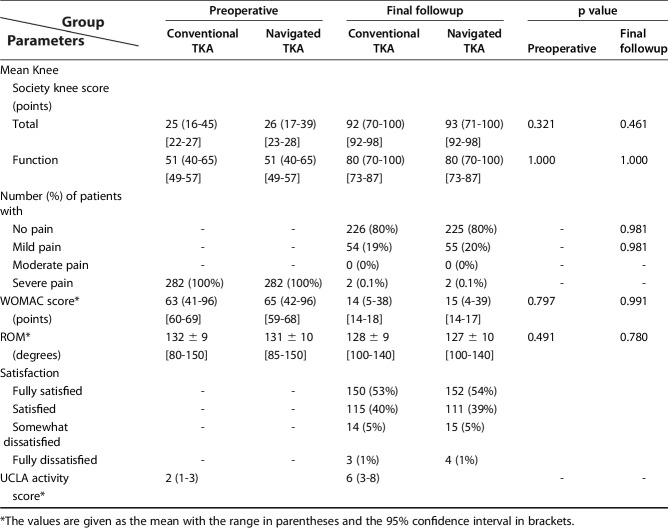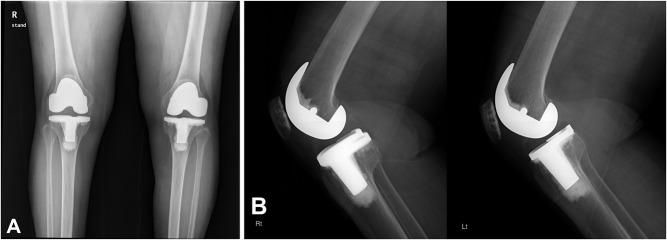Abstract
Background
Proponents of computer-assisted TKA suggest that better alignment of the TKAs will lead to improved long-term patient functional outcome and survivorship of the implants. However, there is little evidence about whether the improved position and alignment of the knee components obtained using computer navigation improve patient function and the longevity of the TKA.
Questions/purposes
The purpose of this study was to determine whether (1) clinical results; (2) radiographic and CT scan results; and (3) the survival rate of TKA components would be better in patients having computer-assisted TKA than results of patients having TKA without computer-assisted TKA. In addition, we determined whether (4) complication rates would be less in the patients with computer-assisted TKA than those in patients with conventional TKA.
Methods
We performed a randomized trial between October 2000 and October 2002 in patients undergoing same-day bilateral TKA; in this trial, one knee was operated on using navigation, and the other knee was operated on without navigation. All 296 patients who underwent same-day bilateral TKA during that period were enrolled. Of those, 282 patients (95%) were accounted for at a mean of 15 years (range, 14-16 years). A total of 79% (223 of 282) were women and the mean age of the patients at the time of index arthroplasty was 59 ± 7 years (range, 48-64 years). Knee Society knee score, WOMAC score, and UCLA activity score were obtained preoperatively and at latest followup. Radiographic measurements were performed including femorotibial angle, position of femoral and tibial components, level of joint line, and posterior condylar offset. Aseptic loosening was defined as a complete radiolucent line > 1 mm in width around any component or migration of any component. Assessors and patients were blind to treatment assignment.
Results
The Knee Society knee (92 ± 8 versus 93 ± 7 points; 95% confidence interval [CI], 92-98; p = 0.461) and function scores (80 ± 11 versus 80 ± 11 points; 95% CI, 73-87; p = 1.000), WOMAC score (14 ± 7 versus 15 ± 8 points; 95% CI, 14-18; p = 0.991), range of knee motion (128° ± 9° versus 127° ± 10°; 95% CI, 100-140; p = 0.780), and UCLA patient activity score (6 versus 6 points; 95% CI, 4-8; p = 1.000) were not different between the two groups at 15 years followup. There were no differences in any radiographic parameters of alignment (on radiography or CT scan) between the two groups. The frequency of aseptic loosening was not different between the two groups (p = 0.918). Kaplan-Meier survivorship of the TKA components was 99% in both groups (95% CI, 93-100) at 15 years as the endpoint of revision or aseptic loosening (p = 0.982). Anterior femoral notching was observed in 11 knees (4%) in the computer-assisted TKA group and none in the conventional TKA group (p = 0.046).
Conclusions
In this randomized trial, with data presented at a minimum of 14 years of followup, we found no benefit to computer navigation in TKA in terms of pain, function, or survivorship. Unless another study at long-term followup identifies an advantage to survivorship, pain, and function, we do not recommend the widespread use of computer navigation in TKA because of its risks (in this series, we observed femoral notching; others have observed pin site fractures) and attendant costs.
Level of Evidence:
Level I, therapeutic study.
Introduction
To reduce malalignment of TKA, computer-assisted TKA was introduced [29, 34]. Advocates of computer-assisted TKA claim that better alignment of the TKA will lead to improved long-term patient functional outcome and survivorship of the implants [20].
However, there is no high-quality evidence from randomized trials at long term of which we are aware evaluating whether the improved position and alignment of the knee components achieved using computer navigation improve patient function or longevity of the TKA [3, 8]. Comparative studies of conventional and computer-assisted TKAs are limited to short-term followup [26, 27, 36, 40]. It seems especially important to evaluate this question in younger patients, because implants in these patients would be expected to be subjected to a longer service life and greater mechanical demands and so might be at greater risk of polyethylene wear, osteolysis, and revision surgery [35, 42].
The purpose of this study was to determine whether (1) clinical results; (2) radiographic and CT scan results; and (3) the survival rate of TKA components would be better in patients having computer-assisted TKA than results of patients having TKA without computer-assisted TKA. In addition, we determined whether (4) complication rates would be less in the patients with computer-assisted TKA than those in patients with conventional TKA.
Materials and Methods
From October 2000 to October 2002, the senior author (Y-HK) performed 592 same-day bilateral TKAs in 296 patients younger than 65 years old under the same anesthetic for end-stage osteoarthritis of both knees. We performed same-day bilateral TKAs in all patients during the study period and 95% of patients (282 of 296) consented to be randomized for this trial. Our institutional review board approved the study and informed consent was obtained from all patients. The inclusion criterion of patients was end-stage osteoarthritis of both knees that warranted TKA. Patients with inflammatory arthritis, a foot and ankle disorder, dementia, or a history of stroke or hip disease were excluded. In the interim, three patients died and 11 were lost to followup; thus, 282 patients (564 knees) were available for clinical and radiographic evaluation at a mean of 15 years (range, 14-16 years) (Fig. 1).
Fig. 1.
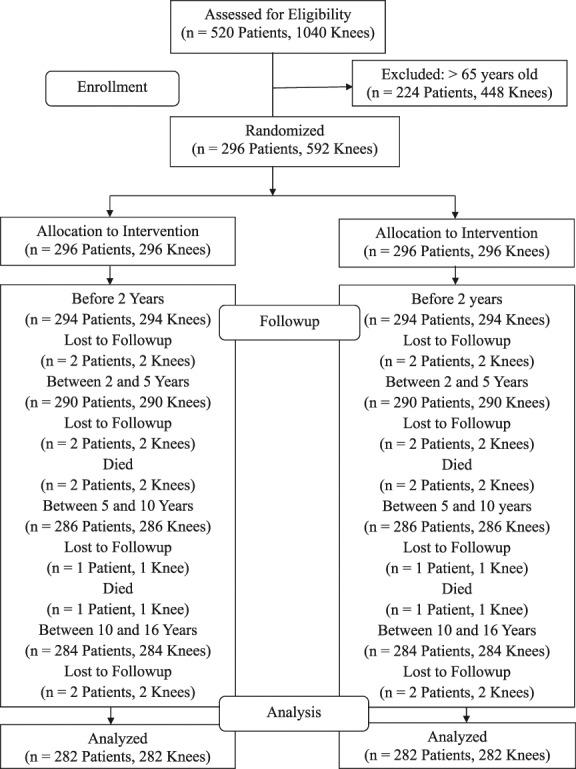
Consolidated Standard of Reporting Trials (CONSORT) flow diagram is illustrated. Five hundred sixty-four knees (in 282 patients) were randomized. Two hundred eighty-two patients with bilateral TKAs had a navigated NexGen PS prosthesis one side and a conventional NexGen PS prosthesis on the other. Followup at a minimum of 14 years was completed for both knees in 282 patients.
Although the learning curve with this navigation system was not addressed in this study, the surgeon who did the procedures in this report (Y-HK) performed 30 navigated TKAs using the system before the first patient was enrolled in this study.
Mean age of patients at the time of index arthroplasty was 59 years (range, 48-64 years); there were 59 men and 223 women (79% women). Mean weight patient was 59 ± 7 kg (range, 48-64 kg), mean height was 151 ± 6 cm (range, 137-181 cm), and mean body mass index was 28 kg/m 2 (range, 25-35 kg/m2). Two hundred fifty-four patients (90%) had genu varum deformities between 5° and 20° and 28 patients (10%) had genu valgum deformities between 8° and 15° as a result of osteoarthritis with Albäck Grade III, V, or V [1] in both knees. Sixty-two patients (22%) had arthroscopic débridement in one or both knees (Table 1).
Table 1.
Demographic data of the 282 patients (564 knees)
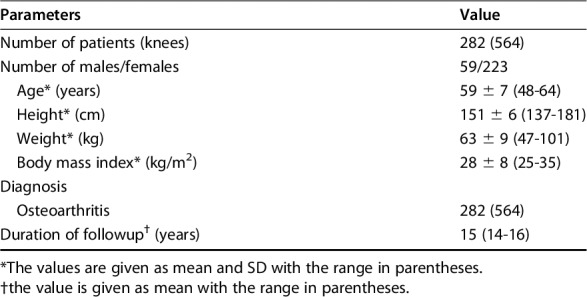
All procedures were performed by the senior author (Y-HK) with tourniquet inflation to 250 mmHg. An anterior midline skin incision was made between 12 and 15 cm long with a medial parapatellar capsular incision. Ten millimeters of tibial bone was resected with a 7° posterior tibial slope. An anterior cortical reference was used for the AP cut of the distal part of the femur. In the conventional TKA group, femoral component rotation was determined with use of three reference axes: (1) the transepicondylar axis; (2) the midtrochlear (Whiteside line [2]); and (3) 3° of external rotation relative to the posterior aspect of the condyles. Ligamentous balance was established first in knee extension and then in knee flexion with use of a tensor. A NexGen posterior cruciate-substituting total knee prosthesis (NexGen® PS; Zimmer, Warsaw, IN, USA) and an all-polyethylene patellar component were used in all knees. All implants were cemented after pulsed lavage irrigation, drying, and pressurization of vacuum-mixed cement. Randomization to a computer-assisted or conventional manual jig-based TKA was done using a sealed study number envelope, which was opened in the operating room before the skin incision was made. All patients were assigned to receive navigated TKA in one knee and conventional TKA in the contralateral knee using a computer program. Before surgery (at baseline), there were no differences between the navigated and nonnavigated knees in terms of preoperative Knee Society knee scores (25 versus 26 points, p = 0.321), Knee Society function scores (51 versus 51 points, p = 1.000), WOMAC scores (63 versus 65 points, p = 0.797), range of knee motion (132° versus 131°, p = 0.491), or UCLA activity score (2 versus 2 points) (Table 2). The navigation system (Vector Vision CT-free knee; Brain LAB, Munich, Germany) that was used had an optical tracking unit, which detected reflecting marker spheres with an infrared camera. In all of the conventional, manual, jig-based TKAs, the femoral component was implanted using intramedullary instrumentation and the tibial component was inserted using extramedullary instrumentation.
Table 2.
Clinical results of 282 patients at final followup (15 years)
On the second postoperative day, we initiated continuous passive ROM and began physical therapy for active mobilization. All patients were discharged home from the hospital. They were allowed full weightbearing and were advised to use crutches or a walker for 4 weeks.
Patients were followed up at 3 months and 1 year after the surgery and then every 2 or 3 years thereafter. Knee Society knee score [19] and WOMAC score [6] were obtained at subsequent followup. Degree of pain with activity was assessed with a visual analog scale (VAS) of 0 to 10. The answers were categorized as none, zero; mild, 1, 2, 3, 4; moderate, 5, 6, 7; or severe, 8, 9, 10. Additionally, UCLA activity score [45] was used to assess patients’ activity level. A standard (60-cm) goniometer was used to measure the range of knee motion preoperatively and at each followup. A research associate (D-RK) who was not part of the operative team recorded and compiled all clinical data.
At each followup examination, we determined, as previously reported [28], the alignment of the limb using a long-leg standing film, including hip and ankle, the position of the components, the joint line, posterior femoral condylar offset, and the presence and location of the radiolucent line. To control rotation of the knee, all radiographs were made under fluoroscopic guidance. A research associate (D-RK) who was not part of the operative team analyzed and recorded radiographic data at each followup.
At the final followup, to determine the rotational alignment of the component and osteolysis, a CT scan was performed in all patients with use of a multislice scanner (General Electric LightSpeed Plus; GE Medical System, Milwaukee, WI, USA). The CT scan was performed from 10 cm above the superior pole of the patella to 10 cm below the tibial tuberosity with use of contiguous 2.5-mm slices. To determine rotational alignment of the femoral component, the angle was measured between the line joining the medial and lateral epicondyles of the femur and that joining the posterior margin of the femoral component. Measurement of axial rotation of the tibial component was carried out in relation to the posterior margins of the medial and lateral tibial plateaus and the posterior margin of the tibial polyethylene insert (Fig. 2). Any nonlinear region of periprosthetic cancellous bone loss with delineable margins was defined as osteolysis. CT scans were examined by one author (Y-HK).
Fig. 2.
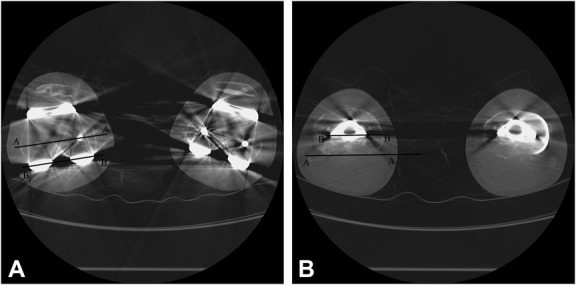
A-B Postoperative CT scan of a 57-year-old woman with osteoarthritis. (A) Measurement of axial rotation of the femoral component in relation to the transepicondylar axis (AA) and the posterior margin of the femoral component (BB). (B) Measurement of axial rotation of the tibial component in relation to the posterior margins of the medial and lateral tibial plateaus (AA) and one joining the posterior margins of the tibial component (BB).
Measurements for all radiologic and CT parameters were performed three times (within a 3-day interval between measurements). The chance-corrected kappa coefficient [32], calculated as previously reported [28] to determine intraobserver agreement for measurements for all radiologic and CT parameters, ranged from 0.96 to 0.98.
Navigation-related complications, including anterior femoral notching, pin site fracture, and pin tract infection, were determined. Also, infection and anterior femoral notching were tallied in both groups.
Statistical Analysis
To minimize the chance of Type II error and increase the power of our study, we adjusted the power to detect a minimum difference in the Knee Society knee score [20] of 5 points with a power of 0.90, which revealed that a total of 254 knees would be required in each group. We recruited approximately 10% more patients to account for possible dropouts. The differences between the two groups with regard to the Knee Society knee and WOMAC scores were evaluated with the paired t-test and the Pearson nonparametric chi-square test. VAS score was assessed using a paired t-test. The range of knee motion was compared between the two groups with a two-way repeated-measures analysis of variance. Nonparametric chi-square tests were used to compare complication rates and radiographic and CT data between the two groups. The level of significance was set at p < 0.05. Kaplan-Meier curves were used to analyze the rate of prosthesis survival with revision for any reason or aseptic loosening as the endpoint [15]; the 95% confidence interval at certain times was calculated with the formula of Greenwood [15].
Results
At latest followup (15 years after the operation), there were no differences between conventional and navigated knees in terms of the mean total Knee Society knee scores (92 ± 8 points versus 93 ± 7 points, respectively; mean difference of 1 point; 95% confidence interval [CI], 92-98 points; p = 0.46). There were no differences between the groups in terms of the proportions of patients with residual pain; in the conventional TKA group, 226 of 280 knees (80%) had no pain, 54 (19%) had mild pain, and two (0.1%) had severe pain at 15 years followup. In the computer-assisted TKA group, 225 of 282 knees (80%) had no pain, 55 (20%) had mild pain, and two (0.1%) had severe pain at 15 years followup (p = 0.981). There were no differences (p = 0.991; 95% CI, 14-18) in the mean WOMAC scores (14 ± 7 and 15 ± 8 points) between the two groups at 15 years followup. The range of knee motion in the conventional TKA group and computer-assisted TKA group was not different preoperatively (132° versus 131°, p = 0.491) or at 15 years followup (128° versus 127°, p = 0.780). Mean UCLA activity score was 6 ± 4 points (95% CI, 4-8 points) at 15 years followup (Table 2).
There was no difference between the groups in terms of the frequency of aseptic loosening; two knees (0.7%) in the conventional TKA group had aseptic loosening of the femoral component and two knees (0.7%) in the computer-assisted TKA group had aseptic loosening of the tibial component (p = 0.918) (Table 3). There was no failure of tibial polyethylene or osteolysis around the components in either group at latest followup (Fig. 3). There were no differences between the two groups at 15 years followup with regard to radiographic parameters, including mean femorotibial angle (5° ± 4° versus 6° ± 3° valgus; 95% CI, 4°-6°), mean femoral component position (coronal plane: 97° versus 98°, 95% CI, 96°-99°, p = 0.812; sagittal plane: 3° versus 3°, 95% CI, 2°-4°, p = 0.431), and mean tibial component position (coronal plane: 89° versus 89°, 95% CI, 87°-90°, p = 0.512; sagittal: 84° versus 83°, 95% CI, 81°-84°, p = 0.541), level of the joint line (15 versus 16 mm; 95% CI, 13-16 mm; p = 0.231), and posterior condylar offset (26 versus 26 mm; 95% CI, 25-27 mm; p = 0.123; Table 3). There was no difference in rotational alignment of the femoral component (6° ± 4° versus 5° ± 5° external rotation; 95% CI, 4°-7°; p = 0.778) or tibial component (7° ± 8° versus 6° ± 9° external rotation; 95% CI, 5°-7°; p = 0.726) in the CT scan between the two groups at 15 years followup.
Table 3.
Radiographic results of 282 patients at final followup (15 years)
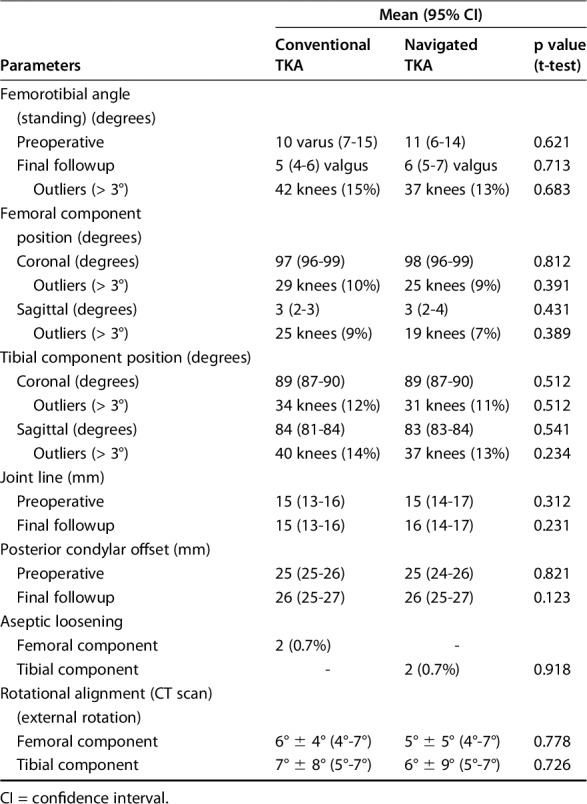
Fig. 3.
A-B Radiographs of both knees of a 53-year-old woman with end-stage osteoarthritis. (A) AP radiograph of both knees taken 15 years after surgery revealing the NexGen PS prosthesis performed with a computer-assisted technique (right knee, shown in the left image) and the NexGen PS prosthesis done with the conventional technique (left knee, shown in the right image) are embedded solidly in a satisfactory position. No radiolucent line or osteolysis is demonstrated adjacent to the tibial component in either knee. (B) Lateral radiographs of the same knees show the absence of radiolucent lines and osteolysis around the femoral, tibial, and patellar components in both knees. (The radiograph of the left knee has been flipped for the sake of better comparison.)
Kaplan-Meier survivorship [24] analysis, with revision or aseptic loosening defined as the endpoint, showed no differences between the groups with a 99% implant survival rate for both groups (95% CI, 93-100) 15 years after the operation (p = 0.982).
Eleven knees (4%) in the computer-assisted TKA group had anterior femoral notching, and no knees with notching were observed in the conventional TKA group (p = 0.046). None of these patients with anterior femoral notching had fractures or lower knee scores than knees without notching. There were no pin tract infections or pin site fractures. Early deep infection developed in two knees (0.7%) in each group. They were treated with open débridement, tibial polyethylene liner change, and intravenous antibiotics for 6 weeks. No infection recurred in these knees, and none of these patients was lost to followup.
Discussion
Proponents of computer-assisted TKA suggest better alignment of the TKAs will lead to improved long-term patient functional outcome and survivorship of the knee implants [20]. However, there is no high-quality evidence from randomized trials at long term whether the improved position and alignment of the knee components by computer navigation improve patient function and longevity of the TKA [3, 8]. The purposes of this study therefore were to determine in long-term followup in the young patients whether (1) clinical results; (2) radiographic and CT scan results; and (3) the survival rate of the TKA implants would be better in computer-assisted TKA than that in conventional TKA. In addition, we assessed whether (4) complication rates were less in computer-assisted TKA than those in conventional TKA.
There are some limitations of this study. First, we performed no interobserver comparisons of the radiologic and CT measurements to confirm the measurements made by one observer, and this can lead to bias in interpreting radiolucent lines, loosening, and osteolysis, leading to errors of either underestimation or overestimation. However, intraobserver agreements for the various radiologic and CT measurements were 0.96 to 0.98, indicating excellent reproducibility. Second, it is frequently difficult for a patient who has undergone bilateral TKA to determine which knee is functioning better than the other. Therefore, the WOMAC function scores should be interpreted with caution because it is difficult for patients to attribute functional status to a particular knee. The components of pain, support, and range of knee motion were initially differentiated, but the components of distance walked and stairclimbing ability were more difficult to differentiate. In these domains, if the patients had difficulties, they identified the knee that limited their activities more, and we adjusted the scores accordingly. Third, in the current series, there were few patients with obesity (28 patients [10%] had > 30 kg/m2 body mass index) and no patients with morbid obesity, a group that may benefit more from navigation given the difficulties associated with identifying anatomic landmarks for accurate component position. However, even if navigation is shown to improve the radiographs of patients with obesity, the question still remains whether it will improve long-term survivorship or clinical outcome scores. Our study does not address this. Fourth, our study population was 79% women with low patient weight and good preoperative range of knee motion; these factors might limit general applicability to other patients or practice settings. On the other hand, the patients in this series engaged in activities such as farming, squatting, and lifting. Finally, this study was limited to a single navigation system.
Other studies have presented conflicting results of computer-assisted TKA. One study suggested that computer-assisted TKA provided better knee function and better quality of life than that achieved with conventional TKA [30], whereas other studies did not find a difference between TKAs performed with or without navigation [17, 23, 27, 39, 41]. Furthermore, Kim et al. [28], in our 11-year followup, found clinical function was not different between the two groups of patients (we note that those patients were not the same patients as we are reporting on in this study). In that study, they indicated that the absence of severe malalignment (≥ 6°) in the conventional TKA group was attributable to similar clinical results as in the computer-assisted TKA group. The findings of our study suggest that there were no differences in Knee Society knee and function scores or WOMAC scores between the two groups at mean 15 years followup.
Bauwens et al. [5], Mielke et al. [37], and Jenny and Boeri [22] found that there was no difference in the postoperative mechanical axis alignment of the limb between the TKAs with and without navigation assistance. By contrast, other investigators reported that computer-assisted TKA produced more accurate alignment than conventional TKA on radiographs [3, 16, 18, 43]. However, Henckel et al. [17] and Krackow et al. [31] suggested that the improvement in the position of the knee components by computer-assisted TKA is only a few degrees, which is within the margin of error produced by projection-related error on standing radiography. Kim et al. [28] found that the implant position and mechanical axis of the limb were not different between the two groups with and without computer-assisted TKAs. In our own work in the current study, we found that there were no differences between the two groups in terms of tibiofemoral alignment, femoral and tibial component position, posterior femoral condylar offset, level of the joint line, and the prevalence of radiolucent lines and loosening.
Baumbach et al. [4], in their 10-year followup study, found that 17% of conventional and 9.8% of computer-assisted TKAs had aseptic loosening. All of the TKAs that developed aseptic loosening in that series presented tibiofemoral angles outside the desired zone of ± 3° around the neutral axis. They concluded that navigation has clinically important advantages with computer-assisted TKA compared with conventional TKA. Our results were different from those of Baumbach et al. [4] in that we had far less aseptic loosening in this series and no differences between the groups in the frequency of this complication. Two knees (0.7%) in each group had aseptic loosening and revision of the components at 15 years followup. We believe that this difference can be attributed to a high proportion of patients within the desired zone of ± 3° in the coronal plane in both the conventional and the navigated groups. A frequency of aseptic loosening of 9.8% to 17% as observed by Baumbach et al. [4] seems extremely high and is not typical for TKA regardless of approach; we believe our results may be more generalizable.
In our series, Kaplan-Meier survivorship of the TKAs revealed 99% in both groups 15 years after the operation. Although TKA is performed with increasing frequency in younger and more active patients, very few long-term studies have been performed in this younger patient population [9, 13, 14, 19]. Most midterm and long-term studies on TKA in younger patients have included a relatively large percentage of patients with rheumatoid arthritis who were somewhat inactive [9, 13, 14, 19]. Several authors [10-13, 25, 31, 38, 40, 44] reported good results of TKA in younger patients with osteoarthritis at long-term followup. Dixon et al. [12] reported 93% survivorship of conventional TKA at 15 years for patients ≤ 67 years. Dalury et al. [10] reported a 98% survivorship rate of conventional TKA at 10 years for patients < 55 years. Kim et al. [24], in their previous study, reported that the survival rate of conventional fixed- or mobile-bearing TKA was 97% at 13 to 14 years in patients < 56 to 59 years of age. In our own study in the current series, excellent survivorship at 15 years was attributable to a good cementing technique with pulsed lavage and cement pressurization, correct flexion and extension gaps, and well-balanced ligaments.
The reason for the higher frequency (4%) of anterior femoral notching in the computer-assisted TKA group is not known. We speculate that there may have been some errors in the navigation registration process. Also, excessive bowing of the femur might be a cause of anterior femoral notching in our 11 knees. Lee and Wang [32] reported that the prevalence of anterior femoral notching by conventional TKA was 5.7% and that for navigated TKA, it was 16.7%. They suggested that a modification of the femoral cut should be considered when substantial femoral bowing is observed. We recommend careful check before femoral cut to avoid anterior femoral notching. Brown et al. [7] reported that pin site fractures occurred in 0.065% of patients (two of 3100). We observed no pin site fracture or pin tract infection in our series.
In this randomized trial, with data presented at a minimum of 14 years of followup, we found no benefit to computer navigation in TKA in terms of pain, function, or survivorship. Unless another study at long-term followup identifies an advantage to survivorship, pain, or function, we do not recommend the widespread use of computer navigation in TKA because of its risks (in this series, we observed femoral notching; others have observed pin site fractures [7]) and attendant costs.
Acknowledgments
We thank Doo-Ri Kim BA, for recording and compiling all clinical and radiographic data.
Footnotes
Each author certifies that neither he, nor any member of his immediate family, have funding or commercial associations (consultancies, stock ownership, equity interest, patent/licensing arrangements, etc) that might pose a conflict of interest in connection with the submitted article.
All ICMJE Conflict of Interest Forms for authors and Clinical Orthopaedics and Related Research® editors and board members are on file with the publication and can be viewed on request.
Clinical Orthopaedics and Related Research® neither advocates nor endorses the use of any treatment, drug, or device. Readers are encouraged to always seek additional information, including FDA-approval status, of any drug or device prior to clinical use.
Each author certifies that his institution approved or waived approval for the human protocol for this investigation, that all investigations were conducted in conformity with ethical principles of research, and that informed consent for participation in the study was obtained.
This work was performed at The Joint Replacement Center, Ewha Womans University, SeoNam and MokDong Hospitals, Seoul, Republic of Korea.
References
- 1.Ahlbäck S. Osteoarthrosis of the knee: a radiographic investigation. Acta Radiol Diagn (Stockh). 1968;277(Suppl):7–72. [PubMed] [Google Scholar]
- 2.Arima J, Whiteside LA, McCarthy DS, Shite SE. Femoral rotational alignment, based on the anteroposterior axis, in total knee arthroplasty in a valgus knee. A technical note. J Bone Joint Surg Am. 1995;77:1331–1334. [DOI] [PubMed] [Google Scholar]
- 3.Bäthis H, Perlick L, Tingart M, Luring C, Zurakowski D, Grifka J. Alignment in total knee arthroplasty. A comparison of computer-assisted surgery with the conventional technique. J Bone Joint Surg Br. 2004;86:682–687. [DOI] [PubMed] [Google Scholar]
- 4.Baumbach JA, Willburger R, Haaker R, Dittrich M, Kohler S. 10-year survival of navigated versus conventional TKAs: a retrospective study. Orthopedics. 2016;39:S72–S76. [DOI] [PubMed] [Google Scholar]
- 5.Bauwens K, Matthes G, Wich M, Gebhard F, Hanson B, Ekkernkamp A, Stengel D. Navigated total knee replacement. A meta-analysis. J Bone Joint Surg Am. 2007;89:261–269. [DOI] [PubMed] [Google Scholar]
- 6.Bellamy N, Buchanana WW, Goldsmith CH, Campbell J, Stitt LW. Validation study of WOMAC: a health status instrument for measuring clinically important patient relevant outcomes to antirheumatic drug therapy in patients with osteoarthritis of the hip or knee. J Rheumatol. 1998;15:1833–1840. [PubMed] [Google Scholar]
- 7.Brown MJ, Matthews JR, Bayers-Thering MT, Phillips MJ, Krackow KA, Low incidence of postoperative complications with navigated total knee arthroplasty. J Arthroplasty. 2017. Feb 3. [Epub ahead of print] [DOI] [PubMed] [Google Scholar]
- 8.Chauhan SK, Scott RG, Breidahl W, Beaver RJ. Computer-assisted knee arthroplasty versus a conventional jig-based technique. A randomized, prospective trial. J Bone Joint Surg Br. 2004;86:372–377. [DOI] [PubMed] [Google Scholar]
- 9.Crowder AR, Duffy GP, Trousdale RT. Long-term results of total knee arthroplasty in young patients with rheumatoid arthritis. J Arthroplasty. 2005;20(Suppl 3):12–16. [DOI] [PubMed] [Google Scholar]
- 10.Dalury DF, Barrett WP, Mason JB, Goldstein WM, Murphy JA, Roche MW. Midterm survival of a contemporary modular total knee replacement: a multicenter study of 1970 knees. J Bone Joint Surg Br. 2008;90:1594–1596. [DOI] [PubMed] [Google Scholar]
- 11.Diduch DR, Insall JN, Scott WN, Scuderi GR, Font-Rodriguez D. Total knee replacement in young, active patients. Long-term follow-up and functional outcome. J Bone Joint Surg Am. 1997;79:575–582. [DOI] [PubMed] [Google Scholar]
- 12.Dixon MC, Brown RR, Parsch D, Scott TD. Modular fixed-bearing total knee arthroplasty with retention of posterior cruciate ligament. A study of patients followed for a minimum of fifteen years. J Bone Joint Surg Am. 2005;87:598–603. [DOI] [PubMed] [Google Scholar]
- 13.Duffy GP, Crowder AR, Trousdale RR, Berry DJ. Cemented total knee arthroplasty using a modern prosthesis in young patients with osteoarthritis. J Arthroplasty. 2007;22(Suppl 2):67–70. [DOI] [PubMed] [Google Scholar]
- 14.Gill GS, Chan KC, Mills DM. 5 to 18-year follow-up study of cemented total knee arthroplasty for patients 55 years old or younger. J Arthroplasty. 1997;12:49–54. [DOI] [PubMed] [Google Scholar]
- 15.Greenwood M. The Natural Duration of Cancer. Reports on Public Health and Medical Subjects. London, UK: Her Majesty’s Stationery Office; 1926:1–26. [Google Scholar]
- 16.Haaker RG, Stockheim M, Kamp M, Proff G, Breitenfelder J, Ottersbach A. Computer-assisted navigation increases precision of component placement in total knee arthroplasty. Clin Orthop Relat Res. 2005;433:152–159. [DOI] [PubMed] [Google Scholar]
- 17.Henckel J, Richards R, Lozhkin K, Harris S, Rodriguez y Baena FM, Barrett AR, Cobb JP. Very low-dose computed tomography for planning and outcome measurement in knee replacement. Bone Joint J. 2006;88:1513–1518. [DOI] [PubMed] [Google Scholar]
- 18.Hernandez-Vaguero D, Suarez-Vazguez A, Iglesias-Fernandez S. Can computer assistance improve the clinical and functional scores in total knee arthroplasty? Clin Orthop Relat Res. 2011;469:3435–3442. [DOI] [PMC free article] [PubMed] [Google Scholar]
- 19.Hofmann AA, Heithoff SM, Camargo M. Cementless total knee arthroplasty in patients 50 years or younger. Clin Orthop Relat Res. 2002;404:102–107. [DOI] [PubMed] [Google Scholar]
- 20.Insall JN, Dorr LD, Scott RD, Scott RN. Rationale of the Knee Society Clinical Rating system. Clin Orthop Relat Res. 1989;248:13–14. [PubMed] [Google Scholar]
- 21.Insall JN, Scuderi GR, Komistek RD, Math K, Dennis DA, Anderson DT. Correlation between condylar lift-off and femoral component alignment. Clin Orthop Relat Res. 2002;403:143–152. [DOI] [PubMed] [Google Scholar]
- 22.Jenny JY, Boeri C. Computer-assisted implantation of total knee prostheses: a case-control comparative study with classical instrumentation. Computer Aided Surg. 2001;6:217–220. [DOI] [PubMed] [Google Scholar]
- 23.Kamat YD, Aurakzai KM, Adhikari AR, Matthews D, Kalairajah Y, Field RE. Does computer navigation in total knee arthroplasty improve patient outcome at midterm follow-up. Int Orthop. 2009;33:1567–1570. [DOI] [PMC free article] [PubMed] [Google Scholar]
- 24.Kaplan EL, Meier P. Nonparametric estimation from incomplete observation. J Am Stat Assoc. 1958;53:457–481. [Google Scholar]
- 25.Kim Y-H, Choi Y, Kim J-S. Osteolysis in well functioning fixed-and mobile-bearing TKAs in younger patients. Clin Orthop Relat Res. 2010;468:3084–3094. [DOI] [PMC free article] [PubMed] [Google Scholar]
- 26.Kim Y-H, Kim J-S, Choi Y-W, Kwon-O-R. Computer assisted surgical navigation does not improve the alignment and orientation of the components in total knee arthroplasty. J Bone Joint Surg Am. 2009;91:14–19. [DOI] [PubMed] [Google Scholar]
- 27.Kim Y-H, Kim J-S, Yoon S-H. Alignment and orientation of the components in total knee replacement with and without navigation support: a prospective, randomized study. J Bone Joint Surg Br. 2007;89:471–476. [DOI] [PubMed] [Google Scholar]
- 28.Kim Y-H, Park J-W, Kim J-S. Computer-navigated versus conventional total knee arthroplasty. A prospective randomized trial. J Bone Joint Surg Am. 2012;94:2017–2024. [DOI] [PubMed] [Google Scholar]
- 29.Kim Y-H, Sohn K-S, Kim J-S. Range of motion of standard and high-flexion posterior stabilized total knee prosthesis. A prospective, randomized study. J Bone Joint Surg Am. 2005;87:1470–1475. [DOI] [PubMed] [Google Scholar]
- 30.Krackow KA, Bayers-Thering M, Philips MJ, Bayers-Thering M, Mihalko WM. A new technique for determining proper mechanical axis alignment during total knee arthroplasty: progress toward computer assisted TKA. Orthopedics. 1999;22:698–702. [PubMed] [Google Scholar]
- 31.Krackow KA, Pepe CL, Galloway EJ. A mathematical analysis of the effect of flexion and rotation on apparent varus/valgus alignment at the knee. Orthopedics. 1990;13:861–868. [DOI] [PubMed] [Google Scholar]
- 32.Landis JR, Koch GG. The measurement of observer agreement for categorical data. Biometrics. 1997;33:159–174. [PubMed] [Google Scholar]
- 33.Lee JH, Wang S-I. Risk of anterior femoral notching in navigated total knee arthroplasty. Clin Orthop Surg. 2015;7:217–224. [DOI] [PMC free article] [PubMed] [Google Scholar]
- 34.Leitner F, Picard F, Minfelde R, Schulz H-J, Cinquin P, Saragaglia D. Computer assisted knee surgical total replacement. In: Caz J, Grimson E, Mösġes R, eds. CVR Med-MR (AS) Heidelberg, Germany: Springer; 1997:629–638. [Google Scholar]
- 35.Lonner JH, Hershman S, Mont M, Lotke PA. Total knee arthroplasty in patients 40 years of age and younger with osteoarthritis. Clin Orthop Relat Res. 2000;380:85–90. [DOI] [PubMed] [Google Scholar]
- 36.Matziolis G, Krocker D, Weiss U, Tohtz S, Perka C. A prospective, randomized study of computer-assisted and conventional total knee arthroplasty. Three dimensional evaluation of implant alignment and rotation. J Bone Joint Surg Am. 2007;89:236–243. [DOI] [PubMed] [Google Scholar]
- 37.Mielke RK, Clemens U, Jens JH, Kershally S. [Navigation in knee endoprosthesis implantation—preliminary experiences and prospective comparative study with conventional implantation technique] [in German]. Z Orthop Ihre Grenzgeb. 2001;139:109–116. [DOI] [PubMed] [Google Scholar]
- 38.Mont MA, Lee CW, Sheldon M, Lennon WC, Hungerford DS. Total knee arthroplasty in patients </= 50 years old. J Arthroplasty. 2002;17:538–543. [DOI] [PubMed] [Google Scholar]
- 39.Seon JK, Park SJ, Lee KB, Li G, Kozanek M, Song EK. Functional comparison of total knee arthroplasty performed with and without a navigation system. Int Orthop. 2009;33:987–990. [DOI] [PMC free article] [PubMed] [Google Scholar]
- 40.Sparmann M, Wolke B, Czupalla H, Banzer D, Zink A. Positioning of total knee arthroplasty with and without navigation support. A prospective, randomized study. J Bone Joint Surg Br. 2003;85:830–835. [PubMed] [Google Scholar]
- 41.Spencer JM, Chauhan SK, Sloan K, Taylor A, Beaver RJ. Computer navigation versus conventional total knee replacement: no difference in functional results at two years. J Bone Joint Surg Br. 2007;89:477–480. [DOI] [PubMed] [Google Scholar]
- 42.Stem SH, Bowen MK, Insall JN, Scuderi GR. Cemented total knee arthroplasty for gonarthrosis in patients 55 years old or younger. Clin Orthop Relat Res. 1990;260:124–129. [PubMed] [Google Scholar]
- 43.Stulberg SD, Loan P, Sarin V. Computer-assisted navigation in total knee replacement: results of an initial experience thirty-five patients. J Bone Joint Surg Am. 2002;84(Suppl 2):90–98. [PubMed] [Google Scholar]
- 44.Tai CC, Cross MJ. Five-to 12- year follow-up of a hydroxyapatite-coated, cementless total knee replacement in young, active patients. J Bone Joint Surg Br. 2006;88:1158–1163. [DOI] [PubMed] [Google Scholar]
- 45.Zahiri CA, Schmalzried TP, Szuszczewicz ES, Amstutz HC. Assessing activity in joint replacement patients. J Arthroplasty. 1998;13:890–895. [DOI] [PubMed] [Google Scholar]



